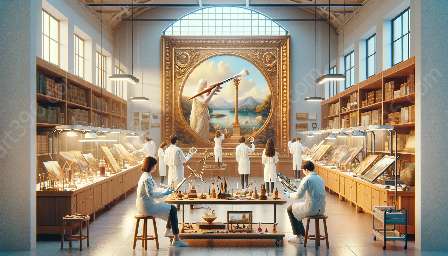Art conservation is a crucial field dedicated to preserving and restoring cultural heritage. It encompasses a wide range of materials, techniques, and approaches aimed at protecting valuable artworks for the enjoyment of future generations. Central to the responsible practice of art conservation is the role of education and training in guiding professionals in the ethical and sustainable use of conservation materials.
The Importance of Education in Art Conservation
Education plays a pivotal role in shaping the practices and choices of art conservators. Through formal education and specialized training programs, conservators gain a deep understanding of the properties of various materials, their interaction with artworks, and the best practices for their application and preservation.
Conservators learn about the chemical compositions, aging processes, and environmental impacts of materials commonly used in art conservation, such as adhesives, consolidants, varnishes, and cleaning agents. This knowledge empowers them to make informed decisions and adopt responsible conservation practices that align with ethical guidelines and sustainability principles.
Training in Material Conservation
Hands-on training and practical experience are equally essential in shaping responsible usage of conservation materials. Through apprenticeships, workshops, and on-site training, conservators develop the necessary skills to handle, apply, and store materials effectively, minimizing risks to the artworks and the environment.
Furthermore, training programs often emphasize the importance of assessing the long-term implications of using specific materials on the stability and authenticity of artworks. This forward-looking approach encourages conservators to prioritize the careful selection and application of conservation materials, considering their potential impact on the cultural significance and integrity of the artworks.
Promoting Ethical Practices
Education and training initiatives in art conservation not only focus on technical competencies but also on fostering ethical and responsible practices. Conservators are encouraged to consider the cultural, historical, and artistic context of each artwork, guiding them to make informed decisions that honor the integrity of the original creation while addressing its preservation needs.
By promoting a deep understanding of the ethical implications of using conservation materials, education and training programs in art conservation instill a sense of responsibility and accountability in conservators. This heightened awareness leads to a more mindful and deliberate approach to material selection, application, and documentation, ensuring that conservation interventions are aligned with the principles of authenticity, respect, and long-term preservation.
Collaborative Initiatives and Knowledge Sharing
Education and training serve as catalysts for collaborative initiatives and knowledge sharing within the art conservation community. By bringing together experts, researchers, and educators, these initiatives facilitate the exchange of best practices, emerging research findings, and advancements in material science, leading to continuous improvement in responsible material usage and conservation techniques.
Conclusion
Education and training are fundamental pillars in promoting the responsible use of conservation materials in art conservation. By equipping conservators with comprehensive knowledge, practical skills, and ethical awareness, these initiatives empower professionals to safeguard cultural heritage with diligence, respect, and sustainability at the core of their practices. Through ongoing education and collaborative endeavors, the art conservation community can continue to evolve and refine its approach to materials, ensuring that future generations can continue to benefit from the preservation of our rich artistic legacy.

